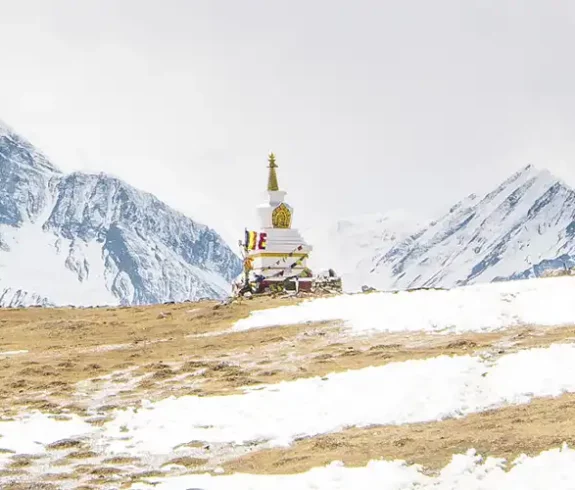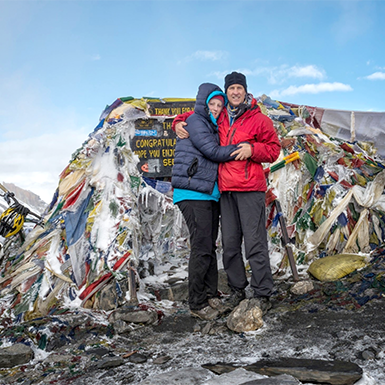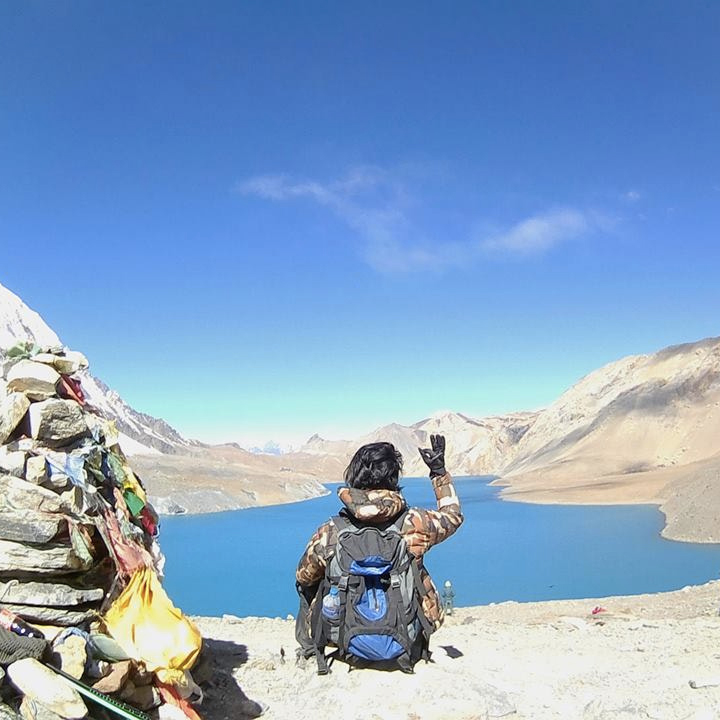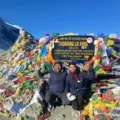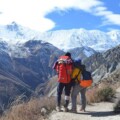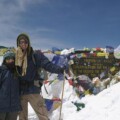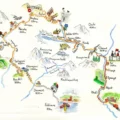Manang Nepal is a place where outstanding landscapes and rich culture meet, all in the heart of the Annapurna region. This mountainous sanctuary located at a high altitude is indispensable for adventurous mountain climbers and those excited about different cultures. It is not only a tourist destination but also serves as a bridge to those mystical rural areas of Nepalese culture that remain wild; thus, Manang represents a paradise for lovers of natural beauty and cultural richness.
Manang is a vital part of the Annapurna Circuit, renowned as one of the globe’s most celebrated trekking routes. The village’s strategic position does more than provide rest for tired trekkers; it allows visitors to explore the area’s diverse ecosystems and the traditional lifestyles of its Himalayan residents. Here’s why Manang is an essential stop:
- High Altitude Preparation: Located over 3,500 meters, Manang assists trekkers in acclimatizing to high altitudes, readying them for subsequent, more demanding climbs.
- Cultural Engagement: Manang introduces visitors to the artistic practices of local communities, including their languages, arts, and religious traditions.
- Exploration of Nature: Manang’s natural attractions are extensive and impressive, with the icy blue Gangapurna Lake and scenic trails to Ice Lake.
- Promotion of Sustainable Tourism: By visiting Manang, tourists support sustainable tourism efforts that promote eco-friendly projects and local economies.

Geography and Accessibility
Manang Nepal lies in the remote Manang District, nestled within the Annapurna Region of central Nepal. Surrounded by the towering Himalayas, it sits at an altitude of approximately 3,500 meters. The district is renowned for its dramatic landscapes, from the sprawling Manang Valley to the snow-capped peaks that dominate the skyline. As part of the Manang Annapurna Circuit, this area is vital for navigating one of the world’s most famous trekking routes. Manang is a destination worth exploring, offering a wealth of cultural and natural attractions.
How to Reach Manang
Reaching Manang requires thoughtful planning, as its remote location can be challenging. Here are the main ways to access Manang:
- Trek from Besishahar: Manang’s most preferred route is trekking from Besishahar, the starting place for the Annapurna circuit. The trek lasts several days and passes through diverse landscapes, including fertile valleys, barren hilly areas, and inhospitable snow-covered mountains with striking views of the Himalayas.
- Flight to Humde Airport: For those seeking a quicker route, flights are available from Pokhara to Humde Airport, located near Manang. This option is ideal for visitors who are short on time or looking to avoid the longer trek. However, weather conditions often affect flight schedules, so flexibility is critical.
- Jeep from Besishahar: Someone recently developed a rough road from Besishahar to Manang. Many opt to take a jeep along this route to save time and energy, especially if trekking the entire circuit is not feasible.
Cultural Insights: A Rich Fusion of Traditions and Tibetan Influence
Manang Nepal is a dynamic cultural center showcasing a rich array of customs, traditions, and ways of life deeply embedded in the Himalayan ethos. This section explores Manang’s distinct cultural attributes and the Tibetan influences that shape its community.
Local Customs and Traditions
The cultural fabric of Manang is as varied as its landscapes. Known locally as Manangis, the residents have shaped a lifestyle that adapts to the rugged mountain environment and preserves rich traditions. Key cultural aspects include:
- Festivals and Celebrations: Manangis hosts traditional festivals highlighting significant annual milestones, blending religious significance with community bonding. These events typically include music, dance, and communal meals.
- Traditional Crafts: In Manang, generations pass down artisan skills such as weaving and embroidery. These crafts are forms of artistic expression and vital components of daily life and the local economy.
- Agricultural Practices: Despite the harsh climate, farming in Manang Valley involves cultivating barley and potatoes and raising livestock. People intertwine these agricultural practices with cultural rituals and collective labor.
Tibetan Cultural Influence
Manang’s proximity to Tibet introduces significant Tibetan cultural elements into local life, observable in several daily aspects:
- Architecture and Monasteries: The architecture in Manang, including its monasteries, showcases Tibetan influences, with prayer flags, wheels, and detailed murals that highlight religious narratives.
- Spiritual Practices: Tibetan Buddhism significantly influences the spiritual practices in Manang. Monasteries in Manang serve as not only places of worship but also community centers for learning and celebrating religious events.
- Language and Clothing: Tibetan and Nepali are both widely spoken in Manang. The traditional Tibetan attire, commonly worn by the locals, mirrors the deep cultural integration.

Weather and Climate: Essential Trekker’s Guide
Navigating the Manang Weather is vital for anyone venturing into the stunning Manang Valley. Positioned high in the Himalayas, Manang features distinctive seasonal changes that significantly affect trekking experiences. This guide outlines the seasonal weather patterns and suggests the best times for your visit.
Understanding Seasonal Weather in Manang
Manang Nepal’s climate, shaped by its high altitude and rugged terrain, presents varied conditions throughout the year:
- Spring (March to May): Spring is the prime season to explore Manang. Mild temperatures make daytime trekking pleasant. Melting winter snows clear the paths and unveil verdant landscapes with blooming rhododendrons.
- Summer/Monsoon (June to August): The monsoon season ushers in heavy rains that make the trails slippery and obscure visibility with frequent cloud cover. Despite the challenges, the rainfall refreshes the valley, dressing it in vibrant green hues. Trekkers should pack waterproof gear and stay alert for possible landslides.
- Autumn (September to November): Autumn contends with spring for the best trekking conditions in Manang. Clear skies and stable weather provide fantastic Himalayan views. However, this popular time on the Manang Annapurna Circuit means busier trails.
- Winter (December to February): Winter brings harsh conditions with low temperatures and frequent snowfalls, leading many guesthouses and paths to close. Adventurous souls that endure the cold are rewarded with tranquil landscapes and thinner crowds, though adequate gear and experience are imperative.
Optimal Times to Visit Based on Weather
The ideal times for trekking in Manang are the spring and autumn months when the weather offers:
- Stable Conditions: Enjoy clear skies and moderate temperatures, ideal for hiking.
- Breathtaking Scenery: Witness the rich floral blooms of spring and the vivid autumn colors during these seasons.
- Accessible Trails: The reduced precipitation during these times makes the trails safer and easier to navigate.
Altitude and Acclimatization: Key Strategies for Trekkers
Trekking in stunning Manang, Nepal requires careful management of the high altitude to ensure a safe and rewarding adventure. This guide delves into strategies for acclimatizing to the high-altitude environment of Manang, which is vital for anyone navigating the Manang Annapurna Circuit.
Understanding Manang Altitude
Manang Nepal stands at about 3,500 meters, from which one can commence the challenging, high-nature trek full of excitement. The thin atmosphere, coupled with reduced volumes of oxygen, is likely to affect one’s body functioning and overall health status.
Effective Acclimatization in Manang
To combat altitude sickness and adapt to the lower oxygen levels in Manang, here are some effective strategies:
- Gradual Elevation Gain: Ascend slowly to prevent altitude sickness. Planning an itinerary that allows for a slow increase in elevation is crucial. Once you arrive in Manang, take additional time to acclimatize before moving on to higher altitudes.
- Scheduled Rest Days: Plan to rest in Manang for one or two days. During these rest days, engage in mild activities such as short hikes that take you slightly higher during the day before returning to a lower altitude for sleep. The “climb high, sleep low” approach is beneficial for acclimatization.
Tips for Adjusting to High Altitudes in Manang
Proper acclimatization can be the difference between a successful trek and health complications. Here are some tips to help you adjust effectively while in Manang:
- Stay Hydrated: Drinking ample water is crucial as dehydration can intensify or mimic the symptoms of altitude sickness.
- Maintain a Carbohydrate-Rich Diet: Eating foods high in carbohydrates is advisable since they are easier to metabolize at higher altitudes and provide essential energy.
- Avoid Alcohol and Tobacco: Both alcohol and smoking can exacerbate altitude sickness symptoms, so it’s best to avoid them during your acclimatization period.
- Monitor Symptoms: Monitor your symptoms closely. Common altitude sickness symptoms include headaches, nausea, dizziness, and disrupted sleep. If symptoms persist or worsen, consider descending to a lower altitude and seeking medical advice.
- Consider Medication: Consult a healthcare provider about medications like Acetazolamide, which can help accelerate your acclimatization by increasing your breathing rate.

Exploring Trekking Routes: Your Adventure Gateway
Manang Nepal is a critical crossroads on the famed Manang Annapurna Circuit, drawing trekkers worldwide to its challenging and picturesque trails. This guide delves into various trekking paths from and leading back to Manang, showcasing the iconic Annapurna Circuit and other less-traveled routes that promise unique adventures, like the trek to Tilicho Lake.
Central Hub on the Annapurna Circuit: Manang’s Strategic Role
Far more than a mere waypoint, Manang is an essential staging area for acclimatizing and gearing up for the more demanding parts of the Annapurna Circuit. Here’s what the trek involves:
- Approaching Manang: The approach to Manang typically starts from Besisahar or Bhulbhule and involves trekking through a mix of environments. Following the path up the Marshyangdi River gives you extraordinary views of verdant landscapes and towering mountains.
- Heading Beyond Manang: After resting in Manang, trekkers press on toward Thorong La Pass, one of the circuit’s highest and most challenging passes. The trek from Manang to the pass offers wide-ranging, spectacular views of the Himalayan expanse.
Beyond the Beaten Path: Alternative Treks from Manang
Manang also serves as a launchpad for several alternative treks that are perfect for those seeking solitude and new vistas:
- Tilicho Lake Trek: As one of the highest lakes globally, Tilicho Lake, at an elevation of approximately 4,919 meters, offers a remote trekking experience. The path diverges from the main Annapurna Circuit close to Manang and winds towards the tranquil, clear waters of Tilicho Lake, providing trekkers with unparalleled scenic views and a peaceful trekking experience.
- Ice Lake (Kicho Tal) Trek: Another invigorating trek from Manang is to Ice Lake. The climb from the village, though steep, rewards trekkers with breathtaking views of the Annapurna range and the serene, high-altitude lake.
- Gangapurna Lake Viewpoint: The walk to the Gangapurna Lake viewpoint is an excellent option for those seeking a lighter trek. This easy trek still offers stunning lake vistas against towering peaks, making it a rewarding experience without the strenuous climb.
Accommodation and Facilities: Essential Guide for Trekkers
Planning your trek to Manang involves more than mapping your route; it’s also about selecting suitable accommodations and knowing the available facilities. This guide offers a detailed look at the various accommodations in Manang, alongside crucial amenities to help trekkers navigate the Manang Annapurna Circuit efficiently and safely.
Accommodation Options in Manang
Manang Nepal caters to a wide range of preferences and budgets, ensuring all trekkers find a suitable place to rest:
- Guesthouses: Predominantly available throughout Manang, these guesthouses offer basic but comfortable rooms, typically with shared bathroom facilities. They are perfect for budget-minded trekkers and provide a warm, communal atmosphere to connect with other travelers.
- Lodges: Manang’s looking for is the next step up if you’re after more comfort. These establishments often feature rooms with private bathrooms and may include additional luxuries like hot showers and WiFi, aimed at trekkers who appreciate a little extra convenience.
- Homestays: For a deep dive into local culture, consider a homestay in the Manang Valley. Staying with a local family lets you experience genuine Nepali hospitality and enjoy homemade traditional meals.
Key Facilities in Manang
Knowing the available facilities in Manang can significantly enhance your trekking experience and ensure both comfort and safety:
- Medical Aid: Given the Manang Altitude, understanding where to find medical assistance is crucial. Manang has several health posts that provide primary healthcare services, including treatments for altitude sickness. Always carry a comprehensive first aid kit and familiarize yourself with the locations of these health posts.
- Communication Options: Although Manang provides specific connectivity options like internet cafes and lodge-based WiFi, mobile network coverage can be unreliable. Plan accordingly to stay connected, especially in remote areas.
- Supplies and Shopping: Manang’s shops are well-stocked with trekking essentials ranging from gear and clothing to snacks and local crafts. Stocking up on necessities like water purification tablets and extra clothing for the cold is highly recommended.
- Dining: The dining facilities in most Manang accommodations offer a blend of local and Western dishes, catering specifically to trekkers. These meals nourish and provide social opportunities to meet fellow trekkers.
Conservation and Local Initiatives: Promoting Sustainable Tourism
As trekkers and adventurers explore the stunning landscapes of Manang Nepal, taking part in local conservation efforts plays an essential role in preserving the environment and culture. This guide highlights the initiatives focused on environmental sustainability and cultural preservation in Manang and offers practical ways for visitors to support these causes while trekking the Manang Annapurna Circuit.
Environmental Sustainability in Manang
The natural beauty of Manang Nepal, faces increasing pressure due to growing tourism and the impact of climate change. Conservation initiatives are working to address these challenges through various programs:
- Waste Management Programs: Reducing litter along trekking routes remains a priority. Local businesses and trekking groups have organized cleanup drives to maintain the trails’ pristine condition. These programs also educate visitors on minimizing their environmental impact and practicing responsible trekking habits.
- Renewable Energy Projects: Manang has embraced solar and hydroelectric power to reduce deforestation and air pollution caused by traditional fuel sources. These renewable energy projects offer cleaner alternatives and set an example for sustainable energy use in remote mountain areas.
Cultural Preservation Efforts in Manang
Manang Nepal boasts a rich cultural heritage, and preserving its traditions is critical to maintaining the area’s identity. Efforts to protect cultural practices include:
- Heritage Restoration Projects: Ongoing projects focus on the restoration of ancient monasteries, traditional homes, and other historical structures that reflect the spiritual and architectural heritage of Manang Valley. These efforts ensure that future generations can experience the region’s rich history.
- Supporting Local Artisans: Programs that encourage the work of local artisans play a vital role in keeping traditional crafts alive. By purchasing locally made items, visitors directly support the local economy and help preserve these crafts for the future.
Community Projects and How Visitors Can Contribute
Visitors to Manang Nepal can engage in various community-driven initiatives contributing to the region’s well-being. Here are ways to get involved:
- Educational Programs: Volunteering in local schools offers a rewarding experience for visitors. Many programs welcome native English speakers to assist with language training, helping to improve the education of young students in the area.
- Eco-Tourism Activities: Nature walks guided by tour guides are examples of eco-friendly tourist activities that enable visitors to learn about local plants and animals, thus supporting conservation initiatives. They also create awareness of the preservation of the area’s ecosystem.
- Cultural Workshops: Participating in artistic workshops, such as traditional cooking classes or craft-making sessions, offers an interactive way to engage with local traditions. These workshops help preserve the cultural practices of Manang and provide visitors with a deeper connection to the community.
Personal Stories and Experiences in Manang Nepal: The Warmth of the Manangi People
Trekkers traveling through Manang Nepal often share heartfelt experiences of the hospitality and kindness of the local Manangi people. Whether braving the challenges of high altitude or enjoying the scenic beauty of the Manang Valley, these encounters add depth to the trekking adventure along the Manang Annapurna Circuit.
A Story of Local Kindness
One trekker, Anya from France, recalls how locals went above and beyond during her stay. “I was struggling with altitude sickness at the high Manang Altitude when a local family took care of me. They offered herbal tea, advice, and comfort, making me feel at home.”
Trekkers Connect with Local Culture
Another adventurer, Michael from Australia, shares how a homestay changed his perspective on trekking. “I stayed with a family in Manang Valley, helping cook traditional meals and sharing stories. Their warmth and generosity made me realize that the trek was about more than just the scenery, the people.”
Conclusion: Why You Should Visit Manang Nepal
Manang Nepal presents travelers with an exceptional opportunity to Encounter both thrilling adventures and cultural fastenings to their being. This high altitudinal destination in stunning Manang Valley is more than a scenic paradise; it is also a tough trekker’s paradise on the Manang Annapurna Circuit. The breathtaking Himalayan vistas and distinctive cultural history will leave an unforgettable impression on visitors to this region.
More importantly, though, Manang Nepal is different from other places because of its warm and friendly nature plus the hospitable individuals that inhabit it, which is like other regions of the same kind but much better. For trekkers who come here, they do not only have enjoyment derived from this beauty but some insights about local life as well. It’s like bringing together different dimensions for a whole day’s happiness.
Practicing Responsible Tourism
You must adhere to appropriate tourism habits as you move through Manang Nepal. Always honor the indigenous customs, observe that our ecosystem is delicate, and converse with the weather in Manang and its altitude. Encourage the conservation of this region by embracing global travel ethics that support safeguarding cultural identities and conserving ecosystems.
